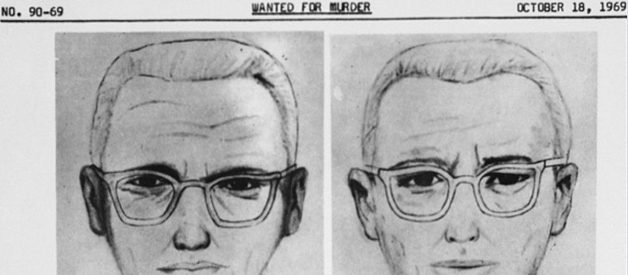Recounting the SFPD?s derailed investigation into one of the nation?s most notorious cold cases.
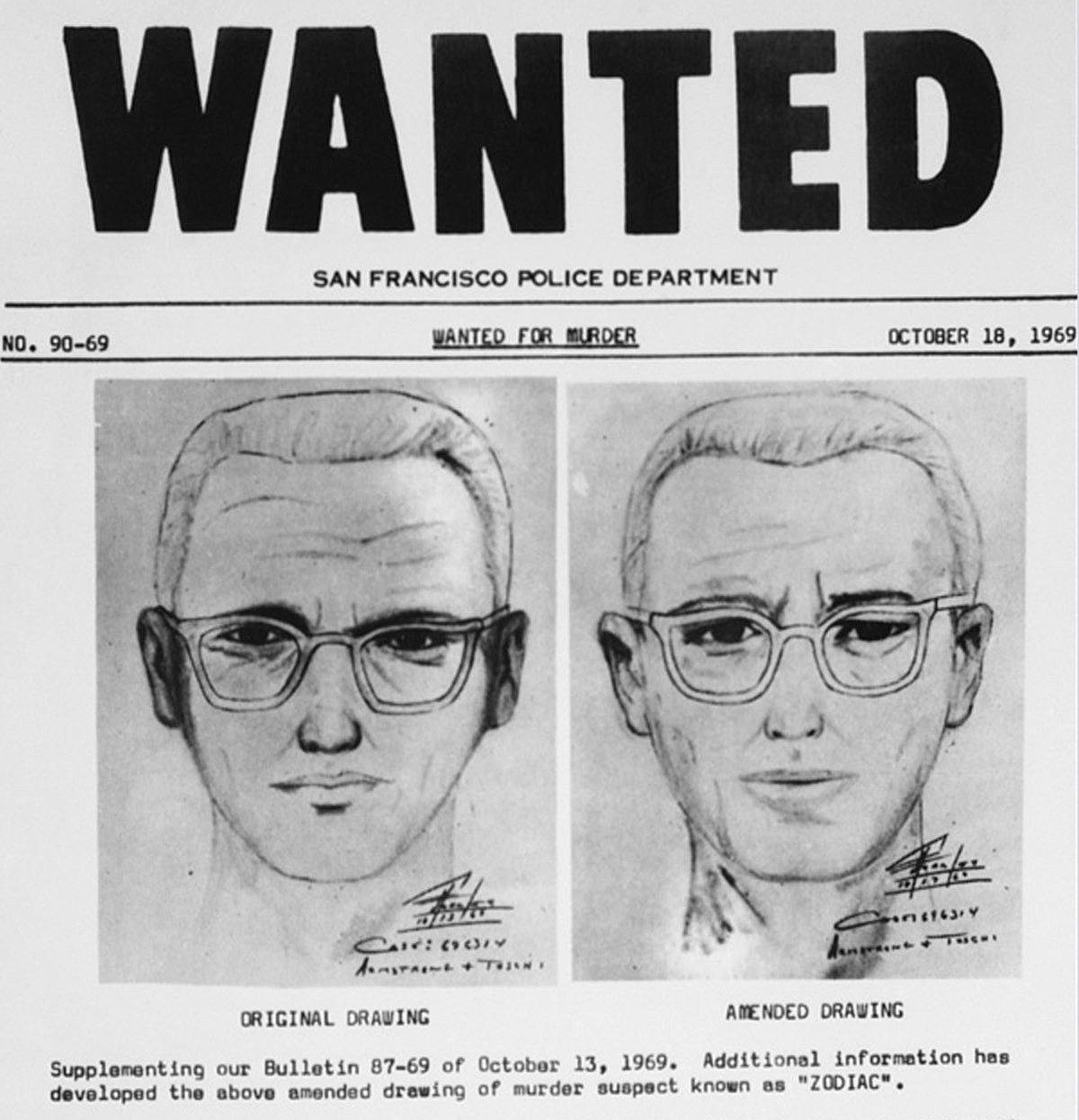 A wanted poster featuring a police sketch of the suspect believed to be the Zodiac Killer, produced after the murder of Paul Stine.
A wanted poster featuring a police sketch of the suspect believed to be the Zodiac Killer, produced after the murder of Paul Stine.
You?ve seen it for years now on TV shows like Cold Case Files and CSI: evidence from a homicide investigation long gone cold is run through new forensic testing years later. Suddenly, a killer who has evaded justice for years or even decades gets tied to a crime by his own archived DNA, and an arrest follows in short order. It?s a scenario that many hoped might lead to a long overdue conclusion in the perennial real-world hunt for San Francisco?s most notorious serial killer?the Zodiac.
Five decades since a pair of young lovers was found executed on a secluded back road, the Zodiac?s killings continue to linger on the fringes of the San Francisco Bay Area?s collective memory like an ominous fog. A multitude of police detectives have followed his trail over the years and found themselves no closer to their quarry than their predecessors were, incurring ulcers and the wrath of superiors in the process. The legacy of the seemingly random killer whose brutal slayings and taunting threats terrorized the Bay Area in the late ?60s and early ?70s is slowly evolving into the nation?s Jack the Ripper, an American fable where truth is more sadistic than fiction. Along the way, the Zodiac case has garnered a cult following, a legion of armchair investigators who publish their theories and debate the evidence in internet chat rooms.
Even today, local law enforcement still fields calls offering tips and leads.
?People call up and say it?s their husband,? said San Francisco Police Department homicide lieutenant John Murphy. At the Napa County Sheriff?s office, authorities estimate about four calls per month. Often it?s one of the many amateurs anxious to share their latest theory. Other times it?s someone who just finished watching an Unsolved Mysteries rerun and thinks his neighbor fits the profile.
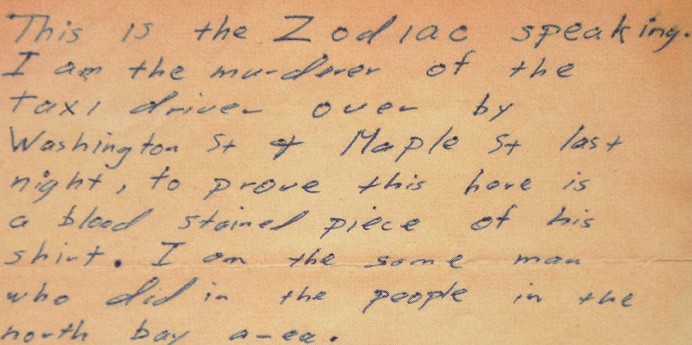 One of the Zodiac?s many taunting correspondence.
One of the Zodiac?s many taunting correspondence.
Half a century of media coverage?books, movies, articles, and TV specials?has kept the case teetering precariously between an official investigation and a sensational mythology. It?s a fitting dynamic, given that the Zodiac himself was a masterful spin doctor. In 2007, the release of David Fincher?s high-profile Hollywood film about the Zodiac brought yet another bout of interest and interpretation to the killer?s legacy.
Yet beneath the cinematic trappings, there remains an open murder investigation that could still conceivably tip the case toward a resolution, with the arrest of a serial killer and a measure of justice for the victims. ?The case still has a lot of potential,? says Michael Kelleher, author of This Is The Zodiac Speaking, a sober, analytical contemplation of the killer?s mind frame. ?It has not been squeezed dry. The answer is almost certainly within the SFPD?s files.?
In fact, in 2002 two SFPD homicide investigators mounted a promising investigation, attempting to cut through the swamp of theories by using the most sophisticated new forensics to thoroughly explore the DNA evidence. But like all things Zodiac, the fresh investigation devolved into a media circus and then a cliff-hanger, as an internal power struggle and the larger political realities buffeting the department led police brass to put the case on the back burner. To many who have studied the case, and at least one who worked it, that decision was an abrupt ending that came just as it seemed a resolution might finally be within reach.
 On December 20, 1968, the Zodiac is believed to have claimed his first two victims: David Faraday And Betty Lou Jensen. This year marks the 50th anniversary of those murders.
On December 20, 1968, the Zodiac is believed to have claimed his first two victims: David Faraday And Betty Lou Jensen. This year marks the 50th anniversary of those murders.
Former vice mayor of Vallejo Tony Pearsall struggles to recall many serious crimes occurring in his days as a young patrolman for the city?s police department. ?Vallejo was a Navy town,? says Pearsall. ?The only major problem we had in my early years was when ships came in and we had to deal with Navy personnel going to the bars and getting into fights or being drunk in public.?
Then, in late December 1968, two students from Vallejo High School, David Farraday and Betty Lou Jensen, were found dead from gunshot wounds on an isolated lovers? lane. There were no signs of robbery or sexual assault. Just murder. Over the course of the next year, the perpetrator would kill three more victims and wound two others in a trio of attacks around the Bay Area in Vallejo, Napa County, and finally San Francisco.
The assaults were as brutal as they were bizarre. Along the remote shore of Lake Berryessa in Napa County, the killer wore a homemade executioner?s costume as he bound Cecelia Shepherd and Bryan Hartnell with rope before repeatedly stabbing them with a hunting knife. Later, in San Francisco?s quiet, affluent Presidio Heights, the assailant who referred to himself in letters to the media as the Zodiac shot cab driver Paul Stine in the head at close range.
?People were terrified,? says Lieutenant Jean Donaldson, former chief Zodiac investigator for the Napa County Sheriff?s Office. ?The killings had occurred in so many different areas and jurisdictions that there was an impression that it could happen anywhere.?
This multi-jurisdictional nature of the case would hinder law enforcement for years to come. ?You didn?t have a lot of cooperation between agencies,? says Pearsall. ?Investigators I talked to were continually frustrated over it, because they never knew if all the agencies were sharing everything with everybody.?
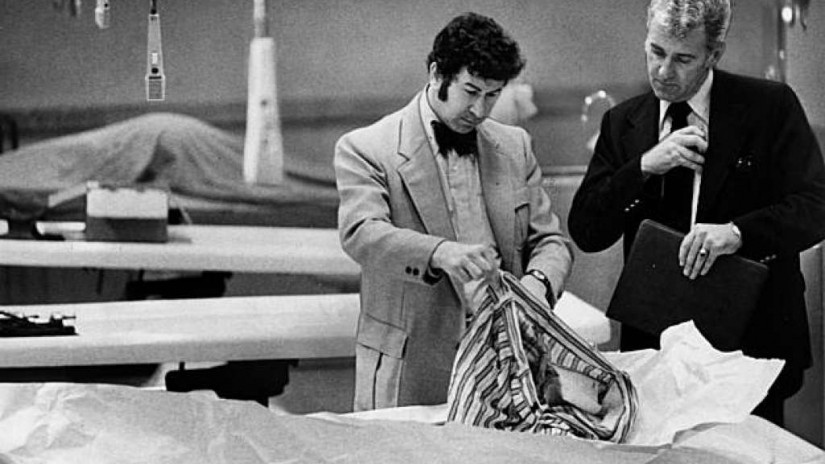 SFPD Inspector David Toschi (left) was among the initial investigators of the Zodiac?s crimes.
SFPD Inspector David Toschi (left) was among the initial investigators of the Zodiac?s crimes.
While the murders were without an obvious motive and logistically complex to investigate, it was the Zodiac?s ability to influence the perception of his crimes that helped make him into the malevolent legend he is today. ?I don?t want to say panic,? says Kelleher, ?but there was a palpable fear that was pervasive throughout the Bay Area. And that was in response to the Zodiac?s letter writing campaign.?
As the killings progressed, so did a taunting series of correspondence from the killer to local media and law enforcement. Like the murders themselves, the Zodiac?s letters were different from anything that had ever been seen before. Following the second Vallejo homicide, he introduced himself with a note to the media citing previously undisclosed details of the first two attacks as well as threats to kill again if his message didn?t find its way to the front page of the local papers. He also included a homemade cryptogram-a puzzle composed of various signs and symbols-which Zodiac suggested would contain a clue to his true identity. Editors from the Bay Area?s local papers, including the San Francisco Chronicle, printed many of these missives beneath screaming headlines.
?It?s sort of like the UFO thing; people see what they want to see.?
?Zodiac was a master manipulator of getting his cryptic little messages on the front pages of at least three different newspapers almost simultaneously,? says Kelleher, ?and the media was willing to go along with the program.?

Over the next nine years around 20 communications purportedly from the killer surfaced, including more puzzles, insults to law enforcement, and of course, graphic threats that spread fear and taxed police resources. ?Zodiac said he was going to kill a kid coming off a school bus,? says Pearsall, ?so we got assigned to follow school buses for an hour or two every morning. And that went on for weeks.? Even at time when DNA analysis was mere science fiction, the killer?s willingness to engage the authorities with a stream of evidence was a risky endeavor.
About a month after the Zodiac?s second Vallejo attack, code breakers in the nation?s most elite agencies-including Naval Intelligence, the National Security Agency, and the Federal Bureau of Investigation-were attempting to crack the first of the killer?s homemade cryptograms. Yet it was local schoolteacher Donald Harden and his wife, Bettye, who within days translated the puzzle to reveal the Zodiac?s disturbing description of how his murders were an effort to ?collect slaves? for the afterlife.

The incident was significant not just for the morbidly fascinating glimpse into the killer?s mind, but because it marked the beginning of a groundswell of amateur involvement in the case. Over time, a considerable subculture has developed around the Zodiac topic.
?As with any case that has some notoriety, you have people who want to be detectives and solve the case,? says Captain Joann West of the Vallejo Police Department. ?Yet they only have a portion of the information; they don?t have the other pieces to the puzzle.?
The confounding facts and buzz of speculation from onlookers rendered the case heavy on question marks and short on periods. Was the subsequent rash of unsolved murders in the Santa Rosa area an indication that the Zodiac did in fact quietly kill over 30 more victims, as he claimed in his later messages? Or, as a tipster told Paul Avery of the the Chronicle, did the sordid saga really start with a strangely similar homicide years earlier down in Riverside, California? Were the small batch of letters that appeared years later ? some in 1974 and one in 1978 ? authentic communications form the Zodiac or mere pranks from copycats?
?The reason his crimes have legs has to do with the cryptic nature of Zodiac himself,? says Kelleher. ?He is a very undefined killer with this mythology built up around him and all of his cryptic nonsense. It?s sort of like the UFO thing; people see what they want to see.?
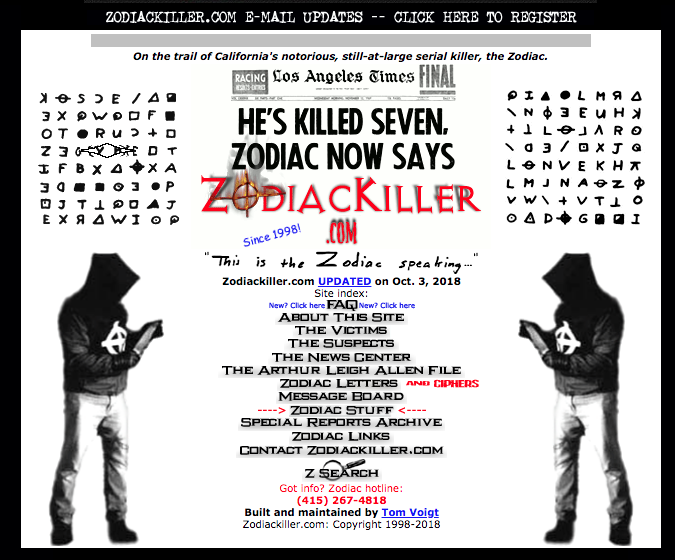 The current home page for Voight?s ZodiacKiller.com
The current home page for Voight?s ZodiacKiller.com
Many amateur-generated Zodiac theories have cropped up over the years, some compelling, others simply confusing. Mike Rodelli, a Zodiac enthusiast from New Jersey, linked the killer to a prestigious San Francisco businessman (never named for fear of legal reprisal and now deceased) who owned a house in Presidio Heights close to the site of the Stine murder and had displayed a propensity for writing hotheaded letters to local newspapers. In his book Times 17, Gareth Penn used complex mathematical computations to arrive at his ?radian theory,? in which he asserted that the Zodiac was a criminal genius who required murders in exact locations in order to fulfill an elaborate occult ritual. Even the Unabomber, Ted Kaczynski, was under scrutiny for a time after two amateur researchers, Douglas Oswell and Michael Rusconi, compiled a digital dossier making the case that he could also have been the Zodiac. Although SFPD investigators were skeptical, they did ask the FBI for Kaczynski?s fingerprints.
Some have even pondered whether recent murders were the Zodiac?s work. In 2004, a young couple were fatally shot in the head on a beach near Jenner in Sonoma County. There were no signs of robbery or sexual assault. Just murder. The incident spurred considerable debate among Zodiac sleuths, many of whom wondered if the resurfacing of the BTK (for Bind, Torture, and Kill) Strangler months earlier in Witchita, Kansas, had somehow catalyzed the Zodiac to kill again, too. ?It was quite a hot topic for awhile,? says Tom Voigt, creator of Zodiackiller.com.
The consensus eventually steered away from a Zodiac connection to the Jenner homicides (which were eventually charged to 38 year old Forestville resident Shaun Gallon in the spring of 2018). But the BTK reference proved relevant in a different sense. In 2005, Witchita police tracked down Dennis Radar, a Cub Scout leader and church official, partly based on his use of a church computer on which letters about the BTK crimes had been written. They arrested him, and he later confessed to the murders, leaving many confident that the Zodiac case was not a lost cause.
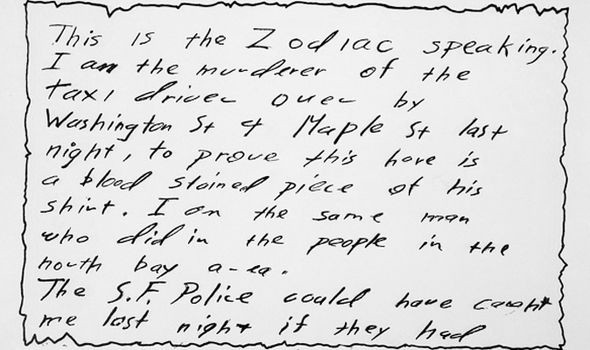
Voigt has given the subculture its hangout. His site is a vast resource of Zodiac-related materials including extensive archives on the case, updates on developments, and most notably, a message board where authors and investigators can debate evidence with hundreds if not thousands of amateur investigators scattered all over the world. Seeking to maintain a high level of knowledge among the message board participants, Voigt no longer lets just anyone participate: ?Now if people want to sign up I give them a little quiz and find out how long they have been following the case, which books they?ve read,? he says.
Kelleher contends that Voigt and those on his message board aren?t just wannabe cops but play a crucial part. ?Their role really shouldn?t be to solve the case,? he says. ?It should be to keep it in the public eye. That?s a very important part of solving a cold case.? It?s a role that?s normally played by the loved ones of murder victims, who sometimes call the police over the years to implore them to keep looking for the killer. In this sense, the Zodiac?s whole community of invested strangers is a unique phenomenon.
Voigt himself is a living encyclopedia of Zodiac knowledge who serves as a custodian of public interest in the case. ?It looked to me,? he explains, ?that the case could be solved if somebody could just collect all the information and put it in one spot to let as many people as possible see it.?
??those past investigations always fell victim to the most basic mistakes an investigator can make, which is they were looking at suspects and not the evidence.?
Before the internet age, however, another archivist had been on the job. Robert Graysmith, author of Zodiac (St. Martin?s Press, 1986), the best-selling account of the murder spree, had extensively researched the saga. A San Francisco Chronicle political cartoonist when the Zodiac was in action, Graysmith was one of the most well-known personalities surrounding the case, and became even more famous still when Paramount Pictures cast Jake Gyllenhaal to play him in David Fincher?s $85 million feature film.
As a bystander whose interest in the murders would coalesce into his own private investigation, Graysmith pulled together a wide range of information from all of the relevant jurisdictions and even tracked down and interviewed witnesses the police hadn?t contacted. ?The Zodiac worked in pictures and symbols,? Graysmith says. ?I was angry at the guy for hijacking art to commit these atrocities. So I thought, ?People will read the book and they will catch the killer.??
In fact, Graysmith contends that his book Zodiac was such a thorough account that investigators in the Vallejo Police Department made it their reference guide. That?s a fascinating point, though it?s one that also serves as a launching pad for Graysmith?s critics. Depending on whom you ask, Graysmith is either the perennial authority who saved the case from obscurity or the original interloper who has obscured the facts surrounding the case.
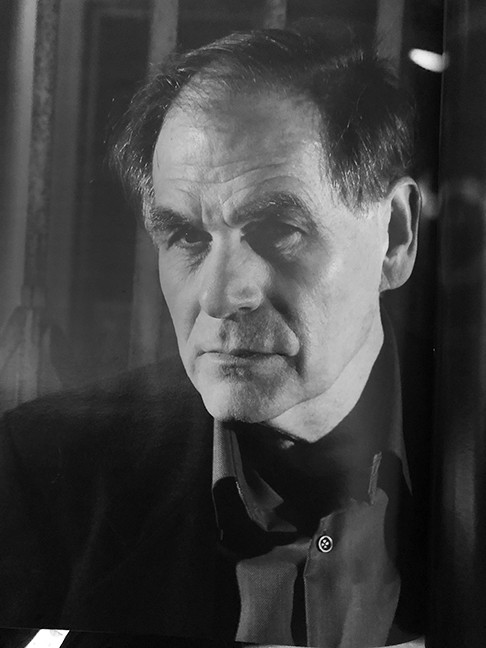 Robert Graysmith, author and original amateur Zodiac sleuth.
Robert Graysmith, author and original amateur Zodiac sleuth.
?Graysmith started the cult,? said retired SFPD inspector Michael Maloney, who deliberately avoided reading Zodiac while investigating the case. ?If we ever had to go to court on the Zodiac case, I didn?t think bringing up a cartoonist?s book would help me.?
As engaging as the book is, it falls short on hard evidence. Graysmith?s pick for the Zodiac, Arthur Leigh Allen, who died of heart failure in 1992, was a convicted pedophile and the investigation?s longtime lead suspect over the years. Allen?s habits, proximity to the crimes, and character all add up to a plausible suspect, and the quiet periods when the Zodiac stopped sending letters to the press even mirror the time that Allen was in prison.
On the other hand, ?Allen?s fingerprints didn?t match, his handwriting didn?t match, his appearance didn?t match,? says Voigt; key forensic details that caused many Zodiac enthusiasts to dispute Graysmith?s conclusions even before any DNA testing was done.
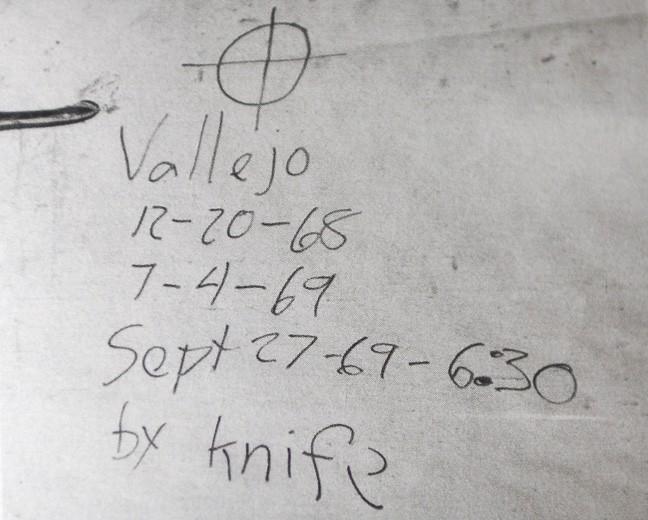
With a long line of Bay Area investigative teams failing to crack the enduring mystery over the years, SFPD homicide inspector Kelly Carroll sought out the case shortly after transferring into homicide in 1999, and soon started making inquiries with his partner, Maloney, into where the DNA-related evidence was.
As Carroll and Maloney pieced together their investigation, authorities in the state of Washington used DNA samples to identify Gary Ridgeway as the heinous Green River Killer, who murdered 48 women. It was a mystery that many had deemed impenetrable, and the mere fact that Ridgeway could be brought to justice after 20 years was encouraging to homicide investigators everywhere.
?DNA analysis is having a huge effect,? says Dr. Norah Rudin of Forensic DNA Consulting and author of An Introduction to DNA Forensic Analysis. ?You see reports every day of cold cases being reinvestigated and answers gotten in cases that previously had no hope of being solved.?
Meanwhile, Harry Phillips, an ABC news producer for such shows as 20/20 and Primetime Live was also intrigued by the prospects of a forensics-heavy analysis of the Zodiac murders.
?The evidence and the files were in an atrocious state ? It was unbelievable, considering that we were dealing with multiple murders.?
?I felt there was a lot of room for skepticism in the previous Zodiac investigations,? says Phillips. ?The principal of those past investigations always fell victim to the most basic mistakes an investigator can make, which is they were looking at suspects and not the evidence.?
Philips soon brokered a deal with SFPD to air the results of its new DNA analysis of Zodiac evidence on a special hour-long episode of ABC?s Primetime Thursday. Given considerable access to the SFPD?s Zodiac files, Phillips was astonished at what Carroll and Maloney were dealing with. ?The evidence and the files were in an atrocious state,? he says. ?It was unbelievable, considering that we were dealing with multiple murders. And the case had so much mystique internally that the evidence had been stolen, rifled, and taken home by retired cops.?
In addition, the climate surrounding the forensics-driven investigation that had inspired the special proved turbulent. A San Francisco Chronicle series in the spring of 2002 found the department ranked dead last in solving violent crime in major American cities. This intensified the political pressure as the city?s murder rate began to climb before an upcoming election year. Furthermore, the high financial cost of DNA analysis combined with the Inspectors? interest in devoting time to a bottom-priority cold case soon placed Maloney and Carroll at odds with their superior, SFPD homicide lieutenant John Hennessey.
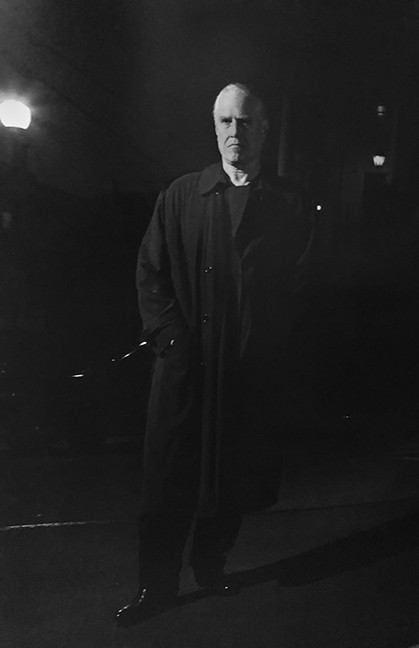 Former SFPD Inspector Michael Maloney had spearheaded the DNA investigation into the Zodiac murders, with his partner Kelly Carroll, during the early 200s.
Former SFPD Inspector Michael Maloney had spearheaded the DNA investigation into the Zodiac murders, with his partner Kelly Carroll, during the early 200s.
Maloney recounted it mostly as a pissing match. ?There were a lot of egos involved,? he said. ?Hennessey didn?t like that Carroll was getting all this attention on the news while he himself was nowhere to be found. We weren?t going to include Hennessey [in the media coverage] if he wasn?t going to support us in our investigation, and he never did. So it was an uphill battle all the way.? [Hennessy, a captain of investigations at the time of this article, did not respond to repeated requests to be interviewed.]
Whether by fate or design, Philips?s Primetime Zodiac special aired at the height of the D.C. sniper killings in October 2002. The crimes were comparable not only for their seeming randomness but for the needling nature of their perpetrators? correspondence with law enforcement. It was a tie-in that Diane Sawyer made good use of in introducing the evening?s special episode.
Philips had marshaled a who?s who of Zodiac figures, including Carroll and Dr. Cydne Holt of the SFPD crime lab, to give perspective on the case and context for the DNA analysis. After Holt failed to find any DNA evidence on the three Zodiac-penned letters allowed for testing by top brass at SFPD, Philips?in a move that was remarkable for both a criminal investigation and show business in general?suddenly produced three more Zodiac letters from a ?retired police source? that were determined to be authentic. The evidence had long been rumored to be haphazardly archived and now Philips was proving it on national television.
Holt found small traces of DNA on material from the letters obtained by Philips. The genetic blueprint was then tested against DNA samples from three men: Arthur Allen Leigh, Rodelli?s anonymous San Francisco businessman (who willingly gave up a DNA sample to prove the charge ?insane?), and a graduate student from New York who became convinced his father was the killer after reading Graysmith?s book.
All three failed to provide a match.
In time, some enthusiasts would criticize the ABC special as sensationalist, a sort of Geraldo-in-Capone?s-vaults take on the Zodiac case. Yet in clearing three suspects after they failed to match up to the forensic evidence, Phillips had actually presented a telling though troubling perspective: after decades of investigation, little more is known about the Zodiac today than when he first appeared.
The Combined DNA Index System (CODIS) is a federally funded computer database containing more than 13 million genetic profiles of convicted felons and suspects. Operating at local, state, and federal levels, it can compare DNA crime scene evidence to those profiles. As of November 2006, CODIS has produced over 415,000 hits, or matches, for more than 390,000 investigations, and has helped to exonerate suspects as well as convict them. ?The databases are so large,? says DNA expert Rudin, ?and so many labs are participating that the number of cold hits actually exceeds the ability of investigators to work the cases.?
 Crime scene photos of the Paul Stine murder.
Crime scene photos of the Paul Stine murder.
Though the DNA sample found by Holt for the Primetime special didn?t render enough genetic material to establish a complete DNA profile of the Zodiac, additional testing of relevant evidence-such as other letters or pieces of Paul Stine?s shirt ? might produce sufficient sampling for entry into the CODIS database.
?You look at our broadcast,? says Philips, ?and you say, ?OK, they came up with a partial DNA profile.? Well, why not fill it out??
Amid the crush of media coverage that came in the following weeks, Maloney and Carroll split on the topic of Allen?s exoneration. Whereas Carroll thought the DNA results cleared the popular suspect, Maloney (like Graysmith and Voigt) believed it was still too soon to reach a firm conclusion. ?Why not test all the evidence?? Maloney said. ?Why not see if it was one person who licked all those stamps or if there was more than one??
?Allen?s fingerprints didn?t match, his handwriting didn?t match, his appearance didn?t match?
Unfortunately, Carroll and Maloney?s relationship with Hennessey had fully deteriorated, and Hennessey halted their investigation and rendered the case inactive in the spring of 2004 before further testing could be done. He cited the lack of significant leads to pursue and the need to reallocate resources to combat the city?s surge in homicides. While the decision dovetailed with the SFPD?s political climate, it sent shock waves throughout the Zodiac community.
?Carroll and Maloney were doing very well with limited support and resources,? says Phillips. ?They were on to something, and it was clear that there was more material to be sampled. The police department closed the case just as they were probably about to make some breakthroughs.?
Voigt broke the story of the case?s inactivity on his site, and he even sent out press releases to inform the media. A few days later, Carroll told the Chronicle that the department still had untested DNA evidence from the Zodiac case, which contradicted Hennessey?s comments a few paragraphs earlier in the same article.
Maloney entered retirement disenchanted with the internal politics of the department he had committed himself to for thirty-some years. In late 2005 he posted a scathing letter on Voigt?s website criticizing Hennessey?s handling of the case and maintaining that his former partner has been forbidden from working on or speaking about the Zodiac case. He cited a small batch of authenticated Zodiac letters still on loan from the Vallejo Police Department as key pieces of evidence that went untested. In early 2007, he passed away from a major heart attack just as renewed interest in the case was building up with the impending release of David Fincher?s film.
Carroll had soon transferred out of homicide to the juvenile division. Likely to be the most knowledgeable law enforcement officers on the topic of the Zodiac case, Carroll had been silenced by SFPD on the topic of the Zodiac (and even responded to an 2007 interview request with a one-line rejection: ?Under Department Directive, Officer Kelly Carroll is prohibited from speaking with the commercial media.?)
When asked to comment on Hennessey?s decision to make the case inactive, former SFPD chief of police Tony Ribera said, ?All police departments must deal with limited resources, which requires managers to set priorities. I know John Hennessey very well, and he?s an outstanding manager.?
But Kelleher sees the situation as more of a political issue than a practical decision. ?[Carroll and Maloney] drew a little too much heat and light at a time when the SFPD was getting slammed for their closure rate,? says Kelleher. ?The lieutenant got really tired of it and got tired of the attention going downstream of him. So it died a political death. It?s surely not the first case.?
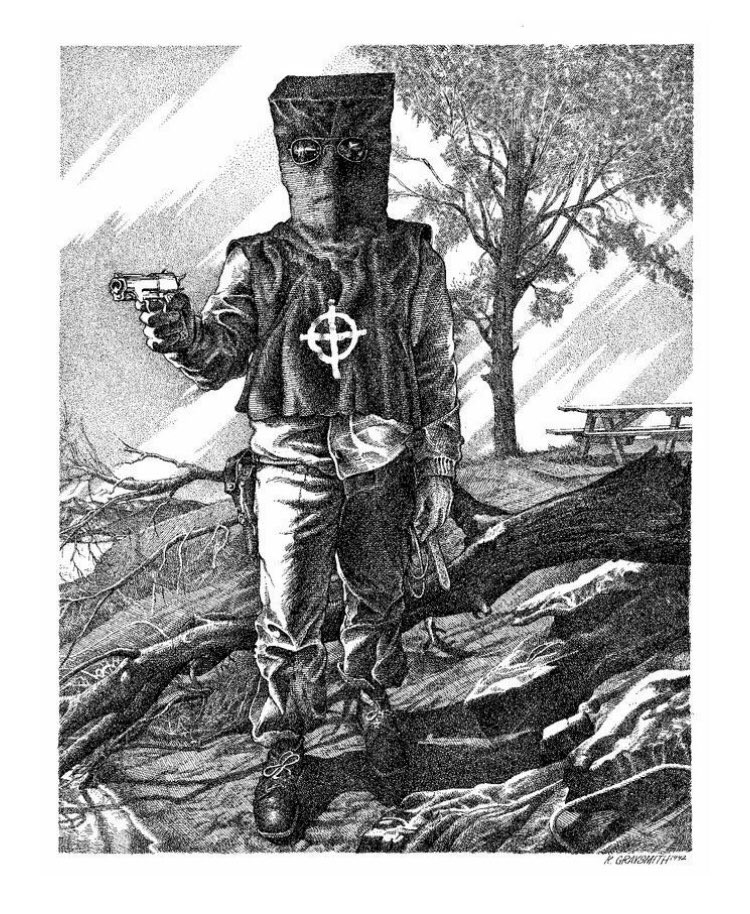 Robert Graysmith famous sketch of the Zodiac?s daytime attack at Lake Berryessa.
Robert Graysmith famous sketch of the Zodiac?s daytime attack at Lake Berryessa.
Over the years, numerous offers have been made to pay for a complete SFPD DNA analysis of the evidence, mostly from media outlets that want first-rights access similar to Phillips?s Primetime episode. Graysmith says he?d be willing to pay for the testing himself. But as far as onlookers know, the department has not taken anyone up on those offers.
If the SFPD has carried out further DNA analysis or even generated a full genetic profile, it?s a tightly held secret. Most assessments suggest the case is a very low priority.
Somewhat surprisingly, Voigt and many other Zodiac enthusiasts remain undiscouraged. They believe that the killer is not only still alive but capable of being brought to justice. ?All those old ideas about serial killers have been proven false in the last few years,? says Voigt, ?the idea that because the guy stops killing, he must be dead?it?s just ridiculous. BTK stopped and he wasn?t dead?he was there the whole time.?
Author?s Note
This article originally appeared in the March 2007 issue of San Francisco Magazine. This current version has undergone minor edits and updates for purposes of clarity and context.
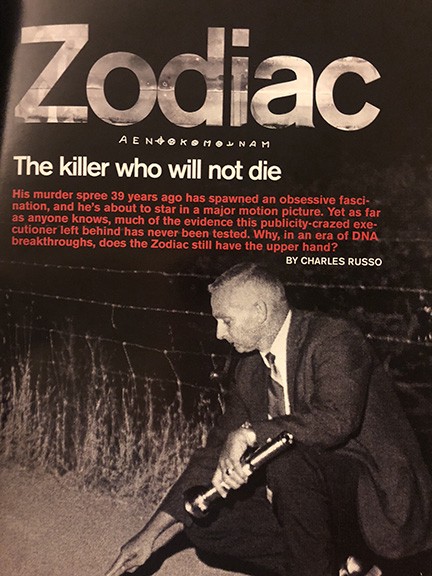
I worked closely with retired SFPD homicide inspector Michael Maloney during the writing of this article, interviewing him on numerous occasions about many different aspects of the case and the politics at SFPD that surrounded it. Maloney had retired highly disillusioned with the SFPD and their handling of this case, particularly the DNA investigation that he attempted to conduct with his partner Kelly Carroll. Tragically, Maloney died from a heart attack shortly before this article was set to run.
One quick post script, which speaks a lot to Maloney?s frustration: When I interviewed ABC producer Harry Phillips about the episode he put together surrounding the testing of the DNA evidence, he reflected on the SFPD with astonishment and concern for how it conducted its affairs, telling me that?mindful of his 30 years covering criminal justice??with the exception of New Orleans at its worse, I have never seen anything quite like the SFPD.?
Charles Russo is a journalist in San Francisco. He is the author of Striking Distance: Bruce Lee and the Dawn of Martial Arts in America, which chronicles the formative days of the martial arts icon amid the trailblazing fight culture on San Francisco Bay during the early 1960s. At present, he is the editor for The Six Fifty, an online magazine covering life and culture around Silicon Valley.
